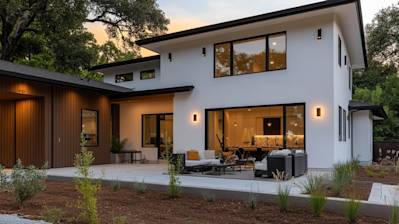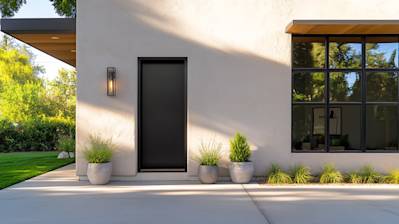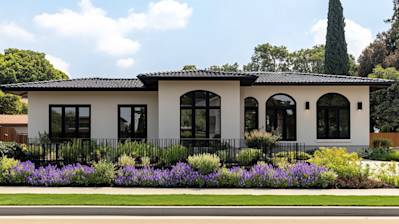In the world of construction and home remodeling, stucco has positioned itself as a reliable and versatile material to apply on exterior and interior walls. However, many homeowners and builders often ask the question, Is stucco good for moisture? This detailed article will delve into the features, effectiveness, and strategies related to stucco and moisture control, and help you comprehend its importance in safeguarding your property against water-related issues.
What Exactly Is Stucco?
Before we continue, it’s significant to understand what stucco is. Crafted from a blend of cement, sand, lime, and water, this durable, hardy material has been used for years to provide an extra layer of protection and aesthetic appeal to buildings. It's celebrated for its affordability, versatility, and longevity, with the ability to resist fire and termites, offering homeowners peace of mind.
The Stucco-Moisture Relationship
Determining whether stucco is good for moisture is essential, given that moisture issues can lead to mold growth, water damage, and structural problems. However, as with many aspects of home construction, there isn't a simple answer. Here's what you need to know:
Stucco’s Natural Moisture-Resistant Properties
Stucco, being a cement-based material, is innately resistant to moisture to an extent. It's designed to fend off certain amounts of rainfall, dew, and general moisture that naturally occurs outdoors. Given its porous nature, it allows moisture to evaporate, preventing water-based damage induced by trapped moisture.
Challenges with Stucco and Moisture
On the flip-side, stucco’s resistance to moisture can be challenged when exposed to consistent or torrential rainfall, or absent proper installation and design features that facilitate moisture control. Water trapped in, under, or behind stucco can lead to issues like peeling paint, efflorescence, or even severe structural damage.
Strategies to Make Stucco Moisture-Resistant
The key to preventing moisture issues with stucco is through proper installation, design elements, and maintenance. Here are a few strategies:
Proper Installation
Correcting stucco installation is of utmost importance to prevent water intrusions. Some key factors include:
- Applying sufficient waterproof barriers behind the stucco.
- Implementing well-fitted flashings at all wall and roof intersections, doors, and windows.
- Creating the right slope on horizontal surfaces to facilitate water drainage.
- Correctly lathing and installing control joints to reduce stucco cracking, which can invite water intrusion.
Adequate Design Features
Features like roof overhangs, gutters, and downspouts, which divert rainfall, can significantly improve stucco's performance in moisture control.
Regular Maintenance and Inspection
This involves regular cleaning, sealing cracks, and painting using high-quality acrylic paints. Regular inspections help detect potential problems, such as cracks caused by building movement or defective installation, which can invite moisture problems.
Frequently Asked Questions about Is Stucco Good For Moisture
Can Stucco Help Prevent Mold Growth in My Home?
Indeed, because of stucco’s moisture-resistant properties, it can greatly help in preventing the growth of mold. Mold typically thrives in damp environments, but stucco, because it resists moisture and allows the underlying structure to breathe, can keep your walls dry and therefore, less prone to mold growth.
What If Moisture Gets Trapped Behind Stucco?
While stucco is moisture-resistant, one of the potential issues that could arise is trapping moisture behind the stucco wall. This can happen if the stucco is improperly installed or if the home doesn't have a proper moisture barrier. Water trapped behind stucco can cause rot or mold growth. If you suspect that there is trapped moisture, it's best to consult a professional who is experienced in stucco application and remediation.
Is Stucco Waterproof?
While stucco is highly moisture resistant, it's important to note that stucco isn't waterproof. Its porous nature allows it to withstand some degree of moisture, but over time, water can still penetrate it. Therefore, it's often advised to use a water-resistant barrier or sealant when applying stucco to enhance its water-resisting capabilities.
How Does Stucco Handle Moisture in High Rainfall Areas?
Stucco handles moisture well in high rainfall areas, thanks to its moisture-wicking properties. The texture of stucco helps to channel water away from the surface which aids in preventing water penetration. However, it is key to ensure that proper flashing and sealing is in place to prevent water from getting trapped behind the stucco.
Can Moisture Damage Stucco?
Excessive exposure to water can potentially damage stucco. Surfaces may show signs of discoloration or cracks, and in severe cases, the stucco may begin to crumble. Hence, even though stucco is moisture-resistant, it's key to maintain it regularly, especially in high moisture environments, and act quickly to address any signs of water damage.
Do I Need to Seal Stucco Against Moisture?
Sealing stucco can provide an extra layer of protection against moisture. Although not always necessary, it can be particularly beneficial in areas of high rainfall or humidity. A good quality sealant can help to repel water, preventing it from seeping into and damaging the stucco.
How Do I Maintain My Stucco in a Moist Environment?
Regular maintenance is key in keeping stucco in top condition in moist environments. This includes routinely checking for signs of dampness, staining or cracking. Also, consider applying a sealant for added water resistance and getting professional help to repair any damage promptly to prevent moisture from getting trapped behind the stucco.
Is Stucco Good for Homes in Tropical Climates?
Yes, stucco is suitable for homes in tropical climates where there is high heat and humidity. Its breathability allows for moisture to evaporate instead of being trapped inside. However, the suitability may also depend on other factors like the building’s design and the quality of the stucco application.
Pros of Using Stucco for Moisture
Durability and Resilience
Sturdy Material
Stucco is a highly durable material and can withstand varying weather conditions. This sturdiness adds to its capability of handling moisture well. The tough nature of Stucco can keep your structure resistant to the entry of water up to a great extent.
Longevity
Stucco being an enduring material, it can last for many decades if applied properly. This implies that your wall will stand resistant to moisture for a longer duration.
Protective Barrier
Repellant to Rainwater
Stucco acts as an excellent barrier against rain. Thus, it can protect your building from getting moist due to rainwater. It is also less prone to degradation resulting from rainwater exposure.
Keeps Out Humidity
Stucco can effectively prevent humidity build-up, especially in areas with high humidity levels. This keeps the internal environment of your building dry and comfortable.
Aesthetics
Provides a Smooth Finish
Stucco is not only durable but also provides a smooth and clean finish. It can successfully hide any fault lines or cracks that may enable the entry of moisture.
Varied Styling Options
Due to the availability of Stucco in a variety of colors and textures, it could be an aesthetic solution for moisture protection. Hence, while providing resistance against moisture, it also amplifies the look of your building.
Cost-effectiveness
Low Maintenance
Stucco requires very minimal maintenance over the years, thus enabling you to save on time, energy, and money that could otherwise be spent dealing with any moisture-related damage.
Less Likely to Require Repainting
Stucco absorbs paint well, reducing the frequency of repainting. This can be beneficial in terms of keeping out moisture too, as frequent painting might weaken the wall and make it more susceptible to moisture.
Cons of Using Stucco for Moisture
Susceptibility to Cracks
Development of Cracks
If not applied properly, Stucco can develop cracks over time. These cracks can serve as pathways for water to seep into your building, thus increasing the moisture problem.
Expansion and Contraction
Stucco expands and contracts with changing temperatures which can lead to cracking. This can create a way for moisture to enter the structure.
Difficulty in Applying
Critical Installation Procedure
The way Stucco is installed can greatly impact its effectiveness against moisture. Any faults in installation could result in moisture seeping through.
Need for Professional Installation
Due to the above point, Stucco often requires professional installation. This could be a downside as it might involve additional costs, thus making it less cost-effective.
Trapping of Moisture
Possibility of Entrapping Water
If not maintained properly, Stucco can trap water against your home's wall. This can lead to a lot of moisture and dampness, and ultimately cause water damage.
Encourages Mold and Mildew Growth
Trapping of water could also promote the growth of mold and mildew which further propagate moisture-related problems.
Limited Repair Options
Difficult and Expensive Repairs
If your Stucco wall has been damaged by water, repairing it can be difficult and expensive. In most cases, you would need professional assistance, adding to the cost.
Matching New Stucco with Old
If a portion of the Stucco needs to be repaired or replaced due to water damage, matching the new Stucco with the old one in terms of color and texture can be challenging. This can affect the overall appearance of your structure.
Summary
To sum it up, it's apparent that stucco isn't just good for moisture, it's outstanding. The concrete blend used in its production makes it highly resistant to water damage, if installed correctly. Stucco also allows for some water penetration, which is then easily evaporated, preventing the build-up of unwanted levels of moisture in your home walls. Its breathability is unrivaled, allowing your home to breathe while protecting it from outsiders.
There's no denying that issues may arise if stucco isn't properly installed or maintained. However, cracking and bulging in stucco, which can lead to moisture build up, are often the result of improper installation rather than the material itself. Hence, when you ask is stucco good for moisture, the answer comes down to a resounding yes, given that the stucco is correctly applied and adequately cared for.
Finally, let's not forget the key part stucco can play in energy efficiency. Stucco's capacity to keep moisture out can significantly control humidity levels indoors. This, coupled with its ability to maintain a steady temperature, can lead to significant energy savings. So, aside from its aesthetic appeal, stucco hits it out of the park in terms of moisture prevention, making it a fantastic choice for residential and commercial buildings alike.
About Atlas Stucco
Atlas Stucco, located in vibrant Sacramento, CA, is a highly-respected, family-owned business that has been elevating the region's design aesthetic for generations. With a single-minded dedication in delivering top-notch stucco services, we've charmed clients with our exceptional workmanship, customer service, and affordable rates. Known for our creativity and attention to detail, we've had the pleasure of transforming countless homes and business spaces in Sacramento, adding character, durability, and elegance. Give us a ring, and let's turn your building goals into stunning reality!
Tags: stucco, moisture resistance, building materials,






